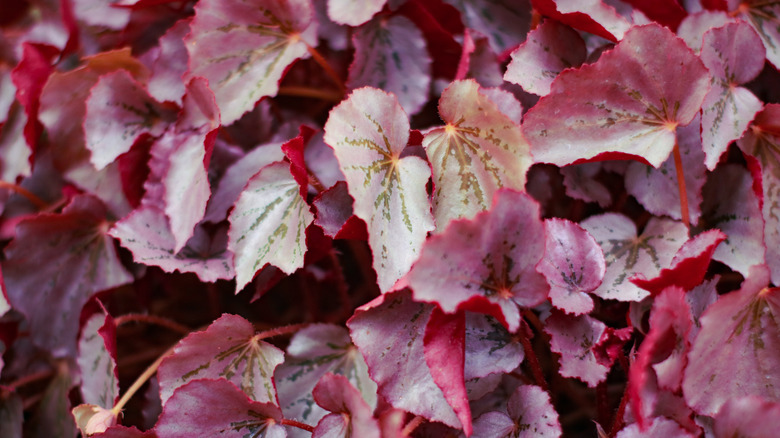How Martha Stewart Propagates Begonias To Grow More Beautiful Plants
The 1,800-plus species and hybrids of the begonia family (Begoniaceae) give gardeners a wide selection of flower colors, leaf styles, and growth patterns. Begonias love humid habitats that offer some shade, such as the greenhouses near Martha Stewart's home in upstate New York. "I am always on the lookout for rare and unusual varieties with interesting forms," Stewart shared on The Martha Blog when explaining how to propagate begonias from stem cuttings. She also documented the process that she and her staff use in a series of gorgeous photos.
Stem cuttings make copies of the original plant when placed in water or damp soil. After spending six to eight weeks forming roots, the new plants can be transferred to garden beds, hanging baskets, or pots with good drainage. To learn which types fare best in each of these environments, read up on different species and hybrids, including begonias that are easy to grow in your home. Many begonias are perennials in USDA hardiness zones 8b to 11. Stewart suggests treating them as annuals in zones 5 and lower. Some types, such as rex begonias (Begonia rex-cultorum), are popular houseplants.
In her post, Stewart noted that any type of begonia can be grown from a stem cutting. One of her strategies is cutting the stem in a way that encourages rooting.
Tips for growing begonias from cuttings
When making a stem cutting, aim for slightly below your begonia's lowest node. This is what Stewart's team does in her greenhouses. A stem that's a couple of inches long is a good start. Stewart shortens each stem to an inch and a half before sliding it into a tray of seed-starting mix featuring perlite, vermiculite, and peat moss. This growing medium is lightweight and retains moisture, helping delicate new plants thrive.
Stewart has an automated Urban Cultivator, but you don't need anything this elaborate to convince your cuttings to root. A plastic salad container makes a budget-friendly planting tray, and most garden centers carry seed-starting mix. Stewart uses this mix to cover the spot where the leaf connects to its stem, known as the petiole. After that, keeping the medium moist is her top priority. Not a fan of seed-starting mix? Place cuttings in a glass of water to coax out their roots. Want to expedite the process? See if rooting hormones can help you multiply your plants. Researchers from Michigan State University found that these compounds can increase rooting speed and root quantity for rex begonias, as well as Reiger and hiemalis begonias (both Begonia x hiemalis).
Stewart recommends avoiding woody stems and keeping your cuttings' leaves from bumping against one another in tight quarters. She also suggests propagating begonias from healthy leaves that drop from mature plants. If the leaf stays damp and receives adequate sunlight, a copy of the original begonia will sprout from the petiole.

